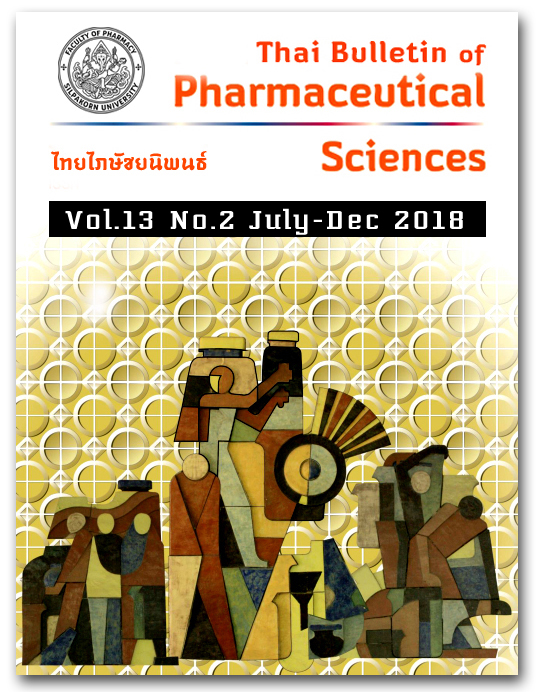ความรู้ทางโภชนาการเกี่ยวกับการควบคุมน้ำหนักของพนักงานองค์กร: กรณีศึกษา บุคลากรสายสนับสนุนวิชาการ คณะวิทยาศาสตร์และคณะศึกษาศาสตร์ มหาวิทยาลัยศิลปากร
DOI:
https://doi.org/10.69598/tbps.13.2.69-85คำสำคัญ:
ความรู้ทางโภชนาการ, การควบคุมน้ำหนัก, การลดน้ำหนัก, ภาวะน้ำหนักเกิน, โรคอ้วนบทคัดย่อ
ภาวะน้ำหนักเกินและโรคอ้วนนำไปสู่โรคไม่ติดต่อเรื้อรังและส่งผลต่อคุณภาพชีวิต การศึกษานี้มีวัตถุประสงค์เพื่อสำรวจความรู้ทางโภชนาการที่เกี่ยวข้องกับการควบคุมน้ำหนักของบุคลากรสายสนับสนุนวิชาการคณะวิทยาศาสตร์และคณะศึกษาศาสตร์ มหาวิทยาลัยศิลปากร ผู้เข้าร่วมการวิจัยจำนวน 110 คน เป็นบุคลากรคณะวิทยาศาสตร์ 69 คนและคณะศึกษาศาสตร์ 41 คน มีอายุเฉลี่ย (ส่วนเบี่ยงเบนมาตรฐาน) เท่ากับ 42.3 (9.3) ปี ส่วนใหญ่ (ร้อยละ 65.5) สำเร็จการศึกษาระดับปริญญาตรีขึ้นไป ผู้เข้าร่วมการวิจัยร้อยละ 67.3 มีภาวะน้ำหนักเกินหรือโรคอ้วน ร้อยละ 50.9 มีภาวะอ้วนลงพุง และร้อยละ 40.0 อยู่ในระหว่างการลดน้ำหนัก เก็บข้อมูลโดยให้ผู้เข้าร่วมการวิจัยตอบแบบประเมินความรู้ทางโภชนาการเกี่ยวกับการควบคุมน้ำหนักด้วยตนเองซึ่งมีคำถามจำนวน 20 ข้อ พบว่าค่ามัธยฐาน (พิสัยควอไทล์) ของคะแนนความรู้เท่ากับ 10.5 (3) คะแนนความรู้ทางโภชนาการสัมพันธ์กับระดับการศึกษา (p = 0.041) และเพศของผู้เข้าร่วมการวิจัย (p = 0.034) สำหรับความรู้สำคัญที่ควรให้คำแนะนำ 3 ลำดับแรกโดยพิจารณาจากจำนวนผู้ที่ตอบคำถามไม่ถูกต้อง คือ คุณค่าทางโภชนาการของฟักทอง (ร้อยละ 79.1) ถั่วเขียว (ร้อยละ 69.1) และถั่วลิสง (ร้อยละ 65.5) นอกจากนี้อีกหนึ่งประเด็นที่ควรให้คำแนะนำตามหลักฐานทางวิทยาศาสตร์ที่มีในปัจจุบัน คือ เรื่อง “น้ำมันมะพร้าวสกัดเย็นกับการลดน้ำหนัก” ซึ่งมีผู้ตอบคำถามไม่ถูกต้องคิดเป็นร้อยละ 63.6 ผู้เข้าร่วมการวิจัยส่วนใหญ่ (ร้อยละ 38.2) ระบุว่าสื่อสังคมออนไลน์เป็นสื่อที่เหมาะสมสำหรับการเผยแพร่ข้อมูลการดูแลสุขภาพ ดังนั้นการให้ความรู้ด้านโภชนาการเพื่อการควบคุมน้ำหนักโดยผู้ประกอบวิชาชีพทางสาธารณสุขผ่านสื่อดังกล่าวน่าจะเป็นประโยชน์ต่อพนักงานองค์กร
เอกสารอ้างอิง
2. Aekplakorn W. Health status. In: Aekplakorn W, editor. Thai National Health Examination Survey, NHES V. Nonthabri: Healthy system research institute, 2014; p. 134. (in Thai)
3. World Health Organization. Noncommunicable diseases country profiles 2014 [Online]. 2014 [cited 2018 Jan 5]; Available from: URL: http://www.who.int/nmh/countries/en/
4. Sheehan AM, Chen JT, Yanovski JA, Calis KA. Obesity. In: Dipiro JT, editors: Pharmacotherapy: a pathophysiologic approach 10th eds. New York: McGraw-Hill Education; 2017; p.2385-402.
5. Garvey WT, Mechanic JI, Brett EM, Garber AJ, Hurley DL, Jastreboff AM, et al. American association of clinical endocrinologists and American college of endocrinology comprehensive clinical practice guidelines for medical care of patients obesity. Endocr Pract. 2016 ;22(suppl 3)
6. Pitayatienanan P, Butchon R, Yothasamut J, Aekplakorn W, Teerawattananon Y, Suksomboon N, et al. Impact of overweight and obesity on health-care costs in Thailand. J Health Syst Res. 2011;5(3):287-98 (in Thai)
7. Boonchayaanant P, Vorasettakarnkij Y, editors. Guideline for overweight and obesity. Bangkok: Network of Fatless Belly Thais. The Royal College of Physician of Thailand; 2015. (in Thai)
8. Paopeng C, Pongutta S, Limwattananon S, Limwattananon C, Chaiyasong S, Tisayaticom K, et al. Food consumption behaviors among different groups of thai population: do demographic, socio-economic, and health status matter? J Health Syst Res. 2011;11(3):287-98. (in Thai)
9. Robert CW. Body mass index as an indicator of obesity. Asia Pacific J Clin Nutr. 2002;11(Suppl):S681–4.
10. Institute of medical research and technology assessment. Clinical practice guideline for management, prevention and treatment of obesity. Nonthaburi; 2010 (in Thai)
11. Sommasut R. Thai food exchange list. Thai JPEN. 2004;15(1):33-45. (in Thai)
12. Research project of nutritional counseling for prevention risk of secondary stroke, Institute of Nutrition Mahidol University. Food exchange lists. [cited 2017 Dec 25] (in Thai); Available from: http://resource.thaihealth.or.th/ library/hot/13411
13. Bureau of Nutrition. Metabolic syndromes. [cited 2015 Jan 10] (in Thai); Available from: http://nutrition.anamai. moph.go.th/images/files/metabolic_syndrome.pdf
14. Institute of Nutrition, Mahidol University. Thai food composition tables 1st eds. Nakhon Pathom; Institute of Nutrition, Mahidol University; 1999.
15. Tepdecha C, Pongsupan J, Leelapattanapanith M, Kaomek M. Knowledge and vegetable consumption of academic supporting staff at Faculty of Pharmacy, Silpakorn University [unpublished research senior project]. Nakhon Pathom: Silpakorn University, 2014. (in Thai)
16. National Institutes of Health National Heart, Lung, and Blood Institute. Third report of the national cholesterol education program (NCEP) expert panel on detection, evaluation, and treatment of high blood cholesterol in adults (Adult Treatment Panel III). [cited 2005 Jan 10]; Available from: https://www.nhlbi.nih.gov/files/docs/ resources/heart/atp-3-cholesterol-full-report.pdf
17. Krishna G, Raj G, Singh BA, Kumar P, Chandrashekar P, Coconut oil: chemistry, production and its applications- a review. Indian Coconut J. 2010;53(3):15-27.
18. Assunção ML, Ferreira HS, dos Santos AF, Cabral CR Jr, Florêncio TM. Effects of dietary coconut oil on the biochemical and anthropometric profiles of women presenting abdominal obesity. Lipids. 2009;44(7):593-601.
19. Eyres L, Eyres MF, Chisholm A, Brown RC. Coconut oil consumption and cardiovascular risk factors in humans. Nutr Rev. 2016;74(4):267-80.
20. Nelms NM, Sucher KP, Long S, editors. Nutrition therapy and pathophysiology. Belmont, CA: Thomson Brooks/Cole; 2007; p. 152-3, 481.
21. Liau KM, Lee YY, Chen CK, Rasool AG. An open-label pilot study to assess the efficacy and safety of virgin coconut oil in reducing visceral adiposity. ISRN Pharmacology 2011, Available from: http://dx.doi.org/ 10.5402/2011/949686
22. Bureau of Nutrition. Edible oil. [cited 2013 Oct 23] (in Thai); Available from: http://www.moph.go.th/ops/iprg /news_pic/บทความเรื่องน้ำมันบริโภค
23. Naidoo J, Willis J. Foundation for health promotion 3rd eds. Edinburgh: Bailliere Tindall/Elsevier; 2009; p.67-83
24. Institute for Population and Social Research, Mahidol University. Thai health report 2016. Nakhon Pathom: Institute for Population and Social Research, Mahidol University; 2016. (in Thai)



